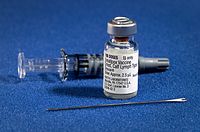
Photo from wikipedia
BACKGROUND With the advent of live-attenuated, quadrivalent, and cell-cultured vaccines for influenza, there have been discussions on the safety of these vaccines compared to conventional vaccines (such as inactivated, trivalent,… Click to show full abstract
BACKGROUND With the advent of live-attenuated, quadrivalent, and cell-cultured vaccines for influenza, there have been discussions on the safety of these vaccines compared to conventional vaccines (such as inactivated, trivalent, and egg-cultured vaccines) because of the development of neurological adverse events (AEs). This study aimed to compare the trends and safety signals in the AE reporting systems of the US and South Korea and, more particularly, to evaluate the association between influenza vaccination and Guillain-Barré syndrome (GBS). METHODS In total, 400,535 AE reports from the US Vaccine Adverse Event Reporting System (VAERS) and 28,766 AE reports from the Korea Adverse Event Reporting System (KAERS) between 2005 and 2017 were assessed. Disproportionality analysis was performed to detect the safety signals and examine the potential risk of GBS with influenza vaccination using the case/non-case approach. RESULTS In both databases, GBS was the most frequently reported AE following influenza immunization. Using the case/non-case approach, the adjusted reporting odds ratio (ROR) of GBS was 3.57 (95% confidence interval [CI], 3.16-4.03) and 3.09 (95% CI, 0.83-11.45) in the VAERS and KAERS data, respectively. People vaccinated with live-attenuated vaccines reported 2.30 times (95% CI, 1.74-3.05) more cases of GBS than those vaccinated with other types of vaccines. CONCLUSIONS Our analysis of the VAERS and KAERS reports for AEs following immunization (AEFI) for influenza shows the need for cautious monitoring regarding the development of GBS after influenza vaccination, particularly, after live-attenuated vaccination. However, owing to potential reporting bias caused by limited AEFI reports after the introduction of new types of influenza vaccines, further prospective safety studies are needed.
Journal Title: Vaccine
Year Published: 2020
Link to full text (if available)
Share on Social Media: Sign Up to like & get
recommendations!